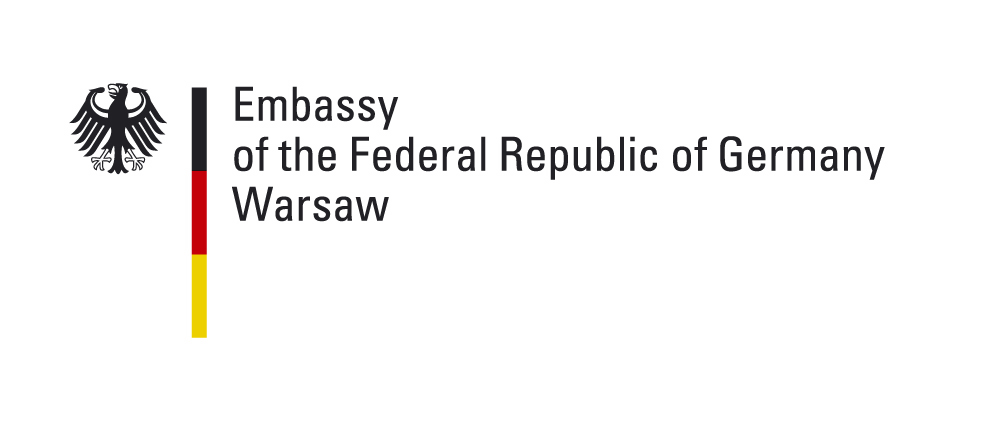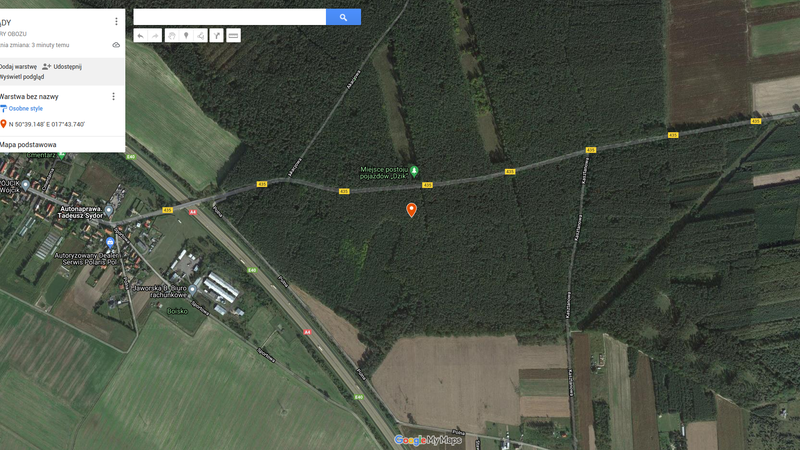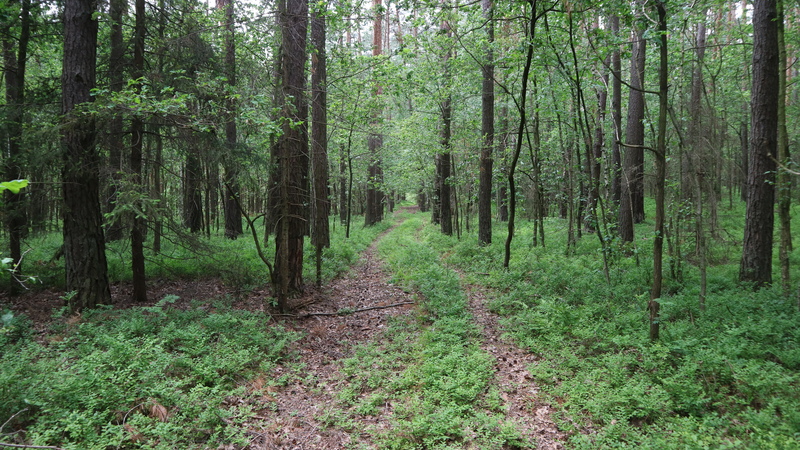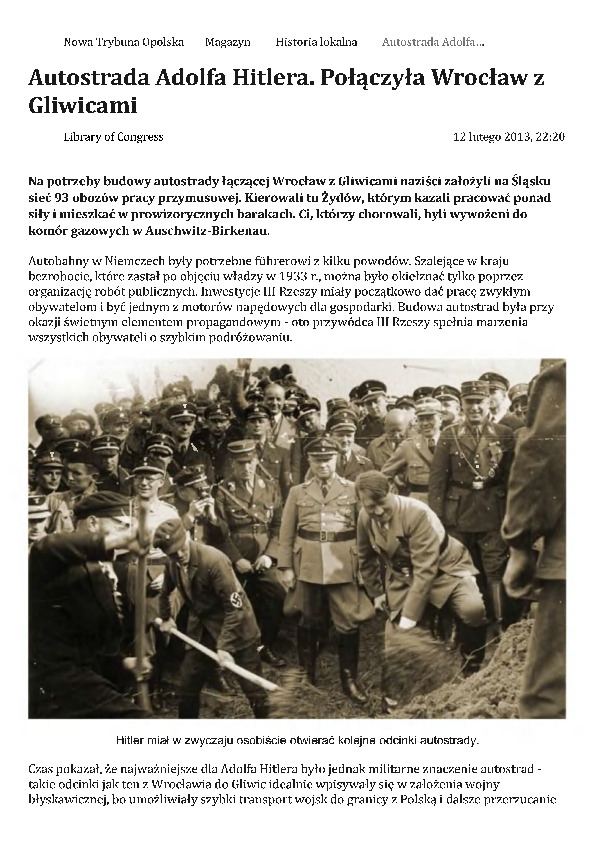Prądy
Borough of Dąbrowa, Oploskie District, Opolskie VoivodshipType of place
A forestInformation about the crime
In 1940, the first Jews were placed in the camp in Prądy. The German name of the camp was KL “RAB Brande”. The contingent consisted of 300 men and 10 women. The camp was located about 365 meters east of the village of Prądy. The first commandant of the camp was Th. Shaha. There were 708 beds in the camp. Witnesses testify that there could have been 800-900 Jews in the camp depending on the period ( 301/921 AŻIH and 301/1228 AŻIH). At the beginning of the camp’s existence, prisoners were employed to build the Wrocław-Katowice highway. The “RAB Brande” camp was one of the 16 RAB camps established due to the construction of the road. The prisoners worked twelve-hour shifts a day, also on Sundays. Those who were unable to work were transferred to the ghettos in Sosnowiec and Będzin.
The resources of the Jewish Historical Institute include a report on German labor camps in the Opole region. There is information about the murder of those who were no longer able to work:
“Those who were weak, exhausted, unable to work were “released” home. But no one saw any people who had returned from the Prądy camp at the station in Komprachcice. This mystery can only be explained by a pine forest. They were probably murdered together with the commando of gravediggers (301/6323 AŻIH). This version of the events is also confirmed by the witness quoted by M. Woźniak: “Nobody saw the sick being taken back. They were probably murdered here and hidden in the forest, one could often hear shots near the cemetery. Gravediggers’ commandos also changed frequently, they were probably liquidated to remove the trace of the crime” (M. Woźniak Obóz Pracy Przymusowej w Prądach – ZAL Brande).
It is impossible to determine the exact number of victims of the camp, but most probably it was about 100. The bodies were buried in the cemetery in Niemodlin and in the “forest cemetery” – a sand pit near the camp. “Half a kilometer from the camp in Prądy, there were many deep pits after excavating the sand for the construction of the road and by the local residents for the construction of their houses. […] Several rows of mass graves were made over a few years (over 130), on which birchen crosses were placed. The cemetery was a calendar of crimes” (301/6323 AŻIH). This is where the bodies were buried. One of the witnesses – Hubert Skrzipczyk “saw several rows of individual graves. Allegedly, each grave was marked with a wooden board with the name and age of the victim on it.” (M. Woźniak).
“As in other RAB camps [Reichsautobahnlager – a camp serving as a base for building highways], Jews in Prądy had a Star of David sewn on their clothes and for a short time they could receive letters and parcels with food and clothes […]. The food was bearable for the first few months, but then it got worse and decreased in quantity. In 1941, the deaths of prisoners as a result of poor nutrition and exhaustion began to occur more and more frequently […]. Throughout 1941, violence increased in the Prądy camp.” (M. Woźniak)
The initial phase of the camp’s existence is remembered very well by Hela F. who came to the camp by one of the first transports. Back then, the violence in the camp was not as intense as in the later stages of its existence. Hela says that the camp commandant treated them then “not that bad”. During her 4-week stay in the camp, however, she saw one case of a murder: „Wachman Lassota went after one Jew and decided to kill him. He sent him outside the camp to get water and shot him, claiming that the Jew was trying to escape.” (301/1228 AŻIH). Szyja F. who survived the camp remembers that: “A Lagerfuhrer is a German, a sadist who abuses us mercilessly and beats us for anything. I remember one time he decided to wake us up in the middle of the night and made us run around the square naked for a couple of hours. […] The sanitary conditions are terrible. Our bathhouse cannot accommodate that many people. When we are not able to wash ourselves with water, we wash ourselves with the coffee that we get for breakfast”(301/921 AŻIH).
SA – the assault troops of the Nazi Party also came to the Prądy camp. They treated the prisoners very brutally, as evidenced by the accounts of several survivors, e.g. they forced prisoners to beat each other on the faces until one of them fell. Subsequent acts of violence included crawling on the snow-covered ground until everyone fell from exhaustion. Apart from this, the deputy camp commandant “often rushed sick and lightly dressed Jews out of the barracks and organized parades for them around the square” in the middle of winter (M. Woźniak). In addition, “one prisoner accused of stealing a carrot was buried up to his chest in a pit where he was kept from morning to night. All the time he had to reach out to the carrot plate placed a little further, out of his reach.” The torture ended with the prisoner’s death.
On January 17, 1942, the construction works of the highway stopped.
“At the end of October 1942, about 500 Jews were imprisoned there […]. In the second half of 1942, Brande began to be used as a hospital camp. Initially, single patients from other nearby camps were brought here, but soon, whole transports with sick Jews from camps in Upper and even Lower Silesia began to arrive in Prądy ” (M. Woźniak). At the end of 1942, the camp in Prądy started to function as a transit camp for prisoners from closed RAB camps and forced laborers. After a month in the camp, one of the prisoners stated that his next camp in Kalecin was “quite nice.” Another prisoner called the camp a slaughterhouse. During this period, there were also deportations of prisoners from Prądy to Auschwitz – for example, on February 13, 1943, about 100 people were deported.
Abraham B., imprisoned in the Brande camp when it was functioning as a transit camp recalls the violence in the camp: “They beat us for the slightest disobedience. The watch commander tormented us the most” (301/1692 AŻIH).
From mid-1943 until the camp was closed at the end of August 1943, it functioned only as a hospital camp. “There were no drugs, so people were writhing in pain and doctors were powerless. Many died of hunger and exhaustion. That is why there were always a few corpses in the linen shed. Bodies had to be buried in common graves” (301/6323 AŻIH).
Commander Kurt Pompe was extremely sadistic. He beat prisoners with a whip, rushed patients out of the infirmary on the charge of simulating diseases, was obsessed with order and, under the pretext of dirt, punished prisoners with a whip. He also used the so-called „Cold showers” – he poured water down the prisoners’ throats until they suffocated to death. Pompe’s bestial behavior is also mentioned by one of the survivors – witness Jakub F.: „There was a famous Lagerfuhrer with one leg, Pompe, who became known for making cold showers for the sick. I met him for the second time when he was a commandant in Schwiederberg, where he was burying the sick people alive” (301/2071 AŻIH).
The camp in Prądy was most probably closed on August 31, 1943.
IDENTIFICATION OF THE GRAVE BASED ON NON INVASIVE RESEARCH
On June 18, 2019, a site inspection was carried out in the presence of a witness who indicated the location of the graves of the victims of the camp (GPS: N 50 ° 39.148 ‘E 017 ° 43.740’). The indicated area is now a forest area with quite dense tree cover, which may make GPR research difficult.
The LiDAR survey reveals numerous violations in this area.
The aerial photography query for this area is ongoing.
Sources
Contact and cooperation
We are still looking for information on the identity of the victims and the location of Jewish graves in Prądy. If you know something more, write to us at the following address: fundacjazapomniane@gmail.com.
Bibliography
Woźniak: Obóz Pracy Przymusowej w Prądach – ZAL Brande <Niemodlin.org>. Niemodlin – Falkenberg O. S. [accessed 2015-06-05]
Sztetl.org: Reichsautobahnlager Brande <https://sztetl.org.pl/pl/miejscowosci/p/1336-prady/116-miejsca-martyrologii/49682-reichsautobahnlager-brande>; [accessed on 6 January, 2022].
Accounts of the survivors from the collections of the Archives of the Jewish Historical Institute in Warsaw:
301/1228 (Fajgenblatt Hela)
301/921 (Szyja Freilich)
301/1692 (Borger Abraham)
301/2071 (Thaler Jakub)
301/6323 (Report on the labor camps for Jews in the villages of Gracze and Prady in the Opole region functioning between 1936 and 1943, the account was written by Kisiel Stanisław)
We would like to thank the Embassy of the Federal Republic of Germany in Warsaw for funding the project “The Future of Our Past. Searching, locating and commemorating forgotten graves of the Holocaust victims ”2021, thanks to which we developed materials about this town.

 prądy fotografia satelitarna 1a
prądy fotografia satelitarna 1a prądy fotografia 1 lokalizacji
prądy fotografia 1 lokalizacji Autostrada Adolfa Hitlera połączyła Wrocław z Gliwicami. Prądy
Autostrada Adolfa Hitlera połączyła Wrocław z Gliwicami. Prądy